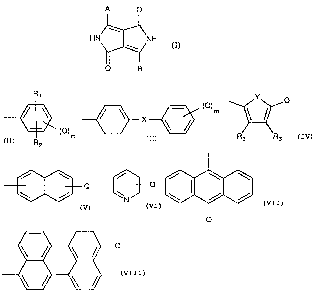Some of the information on this Web page has been provided by external sources. The Government of Canada is not responsible for the accuracy, reliability or currency of the information supplied by external sources. Users wishing to rely upon this information should consult directly with the source of the information. Content provided by external sources is not subject to official languages, privacy and accessibility requirements.
Any discrepancies in the text and image of the Claims and Abstract are due to differing posting times. Text of the Claims and Abstract are posted:
| (12) Patent: | (11) CA 2128265 |
|---|---|
| (54) English Title: | POLYAMIDES MASS COLOURED WITH DIKETOPYRROLOPYRROLE PIGMENTS |
| (54) French Title: | POLYAMIDES COLORES AVEC DES PIGMENTS DE DICETOPYRROLOPYRROLE |
| Status: | Expired and beyond the Period of Reversal |
| (51) International Patent Classification (IPC): |
|
|---|---|
| (72) Inventors : |
|
| (73) Owners : |
|
| (71) Applicants : |
|
| (74) Agent: | SMART & BIGGAR LP |
| (74) Associate agent: | |
| (45) Issued: | 2004-09-14 |
| (22) Filed Date: | 1994-07-18 |
| (41) Open to Public Inspection: | 1995-01-21 |
| Examination requested: | 2001-07-16 |
| Availability of licence: | N/A |
| Dedicated to the Public: | N/A |
| (25) Language of filing: | English |
| Patent Cooperation Treaty (PCT): | No |
|---|
| (30) Application Priority Data: | ||||||
|---|---|---|---|---|---|---|
|
Mass-coloured synthetic polyamide containing, as pigment, at least one
diketopyrrolopyrrole pigment of formula
<IMG>
wherein A and B are each independently of the other a radical of formula
<IMG>
2
wherein Q is a -CONH2 group,
m is 1 or 2,
R1 and R2 are each independently of the other hydrogen, Cl, Br, CH3 or C2H5,
R3 is hydrogen, CH3, C2H5 or phenyl,
X is a direct bond, -O-, -S-, -SO2-, -CH=CH-, -CH2- or -C(CH3)2-, and
Y is -O- or -S-.
Polyamides mass-coloured with the pigments useful in the practice of this
invention have
exceptional heat stability and excellent lightfastness.
Note: Claims are shown in the official language in which they were submitted.
Note: Descriptions are shown in the official language in which they were submitted.

2024-08-01:As part of the Next Generation Patents (NGP) transition, the Canadian Patents Database (CPD) now contains a more detailed Event History, which replicates the Event Log of our new back-office solution.
Please note that "Inactive:" events refers to events no longer in use in our new back-office solution.
For a clearer understanding of the status of the application/patent presented on this page, the site Disclaimer , as well as the definitions for Patent , Event History , Maintenance Fee and Payment History should be consulted.
| Description | Date |
|---|---|
| Time Limit for Reversal Expired | 2006-07-18 |
| Inactive: IPC from MCD | 2006-03-11 |
| Inactive: IPC from MCD | 2006-03-11 |
| Letter Sent | 2005-07-18 |
| Grant by Issuance | 2004-09-14 |
| Inactive: Cover page published | 2004-09-13 |
| Pre-grant | 2004-05-07 |
| Inactive: Final fee received | 2004-05-07 |
| Letter Sent | 2003-11-10 |
| Notice of Allowance is Issued | 2003-11-10 |
| Notice of Allowance is Issued | 2003-11-10 |
| Inactive: Approved for allowance (AFA) | 2003-10-30 |
| Letter Sent | 2001-08-03 |
| Inactive: Status info is complete as of Log entry date | 2001-08-03 |
| Inactive: Application prosecuted on TS as of Log entry date | 2001-08-03 |
| All Requirements for Examination Determined Compliant | 2001-07-16 |
| Request for Examination Requirements Determined Compliant | 2001-07-16 |
| Application Published (Open to Public Inspection) | 1995-01-21 |
There is no abandonment history.
The last payment was received on 2004-06-21
Note : If the full payment has not been received on or before the date indicated, a further fee may be required which may be one of the following
Please refer to the CIPO Patent Fees web page to see all current fee amounts.
| Fee Type | Anniversary Year | Due Date | Paid Date |
|---|---|---|---|
| Registration of a document | 1997-07-14 | ||
| MF (application, 4th anniv.) - standard | 04 | 1998-07-20 | 1998-06-03 |
| MF (application, 5th anniv.) - standard | 05 | 1999-07-19 | 1999-06-01 |
| MF (application, 6th anniv.) - standard | 06 | 2000-07-18 | 2000-06-05 |
| MF (application, 7th anniv.) - standard | 07 | 2001-07-18 | 2001-06-07 |
| Request for examination - standard | 2001-07-16 | ||
| MF (application, 8th anniv.) - standard | 08 | 2002-07-18 | 2002-06-14 |
| MF (application, 9th anniv.) - standard | 09 | 2003-07-18 | 2003-06-10 |
| Final fee - standard | 2004-05-07 | ||
| MF (application, 10th anniv.) - standard | 10 | 2004-07-19 | 2004-06-21 |
Note: Records showing the ownership history in alphabetical order.
| Current Owners on Record |
|---|
| CIBA-GEIGY AG |
| CIBA SPECIALTY CHEMICALS HOLDING INC. |
| Past Owners on Record |
|---|
| BERND LAMATSCH |
| OLOF WALLQUIST |